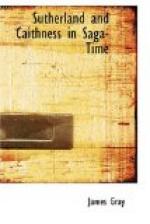Meantime, during the centuries which elapsed before the Catholic Church reached the extreme north of Scotland, the Pictish and Columban churches held the field, as rivals, there, and probably never wholly perished in Norse times even in Caithness and Sutherland.
During these centuries there were constant wars among the Picts themselves, and later between them and the Scots, resulting, generally, in the Picts being driven eastward and northward from the south centre of Alban, which the Scots seized, into the Grampian hills.
After this very brief statement of previous history we may now attempt to give some description of the land and the people of Caithness and Sutherland as the Northmen found them in the ninth century.
CHAPTER II.
The Pict and the Northman.
The present counties of Caithness and Sutherland A together made up the old Province of Cait or Cat, so called after the name of one of the seven legendary sons of Cruithne, the eponymous hero who represented the Picts of Alban, as the whole mainland north of the Forth was then called, and whose seven sons’ names were said to stand for its seven main divisions,[1] Cait for Caithness and Sutherland, Ce for Keith or Mar, Cirig for Magh-Circinn or Mearns, Fib for Fife, Fidach (Woody) for Moray, Fotla for Ath-Fodla or Athol, and Fortrenn for Menteith.
Immediately to the south of Cat lay the great province of Moray including Ross, and, in the extreme west, a part of north Argyll; and the boundary between Cat and Ross was approximately the tidal River Oykel, called by the Norse Ekkjal, the northern and perhaps also the southern bank of which probably formed the ranges of hills known in the time of the earliest Norse jarls as Ekkjals-bakki. Everywhere else Cat was bounded by the open sea, of which the Norse soon became masters, namely on the west by the Minch, on the north by the North Atlantic and Pentland Firth, and on the east and south by the North Sea; and the great valley of the Oykel and the Dornoch Firth made Cat almost into an island.
Like Caesar’s Gaul, Cat was “divided into three parts”; first, Ness, which was co-extensive with the modern county of Caithness, a treeless land, excellent in crops and highly cultivated in the north-east, but elsewhere mainly made up of peat mosses, flagstones and flatness, save in its western and south-western borderland of hills; secondly, to the west of Ness, Strathnavern, a land of dales and hills, and, especially in its western parts, of peaks; and, thirdly, to the south of Strathnavern, Sudrland, or the Southland, a riviera of pastoral links and fertile ploughland, sheltered on the north by its own forests and hills, and sloping, throughout its whole length from the Oykel to the Ord of Caithness, towards the Breithisjorthr, Broadfjord, or Moray Firth, its southern sea.[2]




